stop start TOYOTA PRIUS PLUG-IN HYBRID 2014 1.G Quick Reference Guide
[x] Cancel search | Manufacturer: TOYOTA, Model Year: 2014, Model line: PRIUS PLUG-IN HYBRID, Model: TOYOTA PRIUS PLUG-IN HYBRID 2014 1.GPages: 40, PDF Size: 4.58 MB
Page 14 of 40
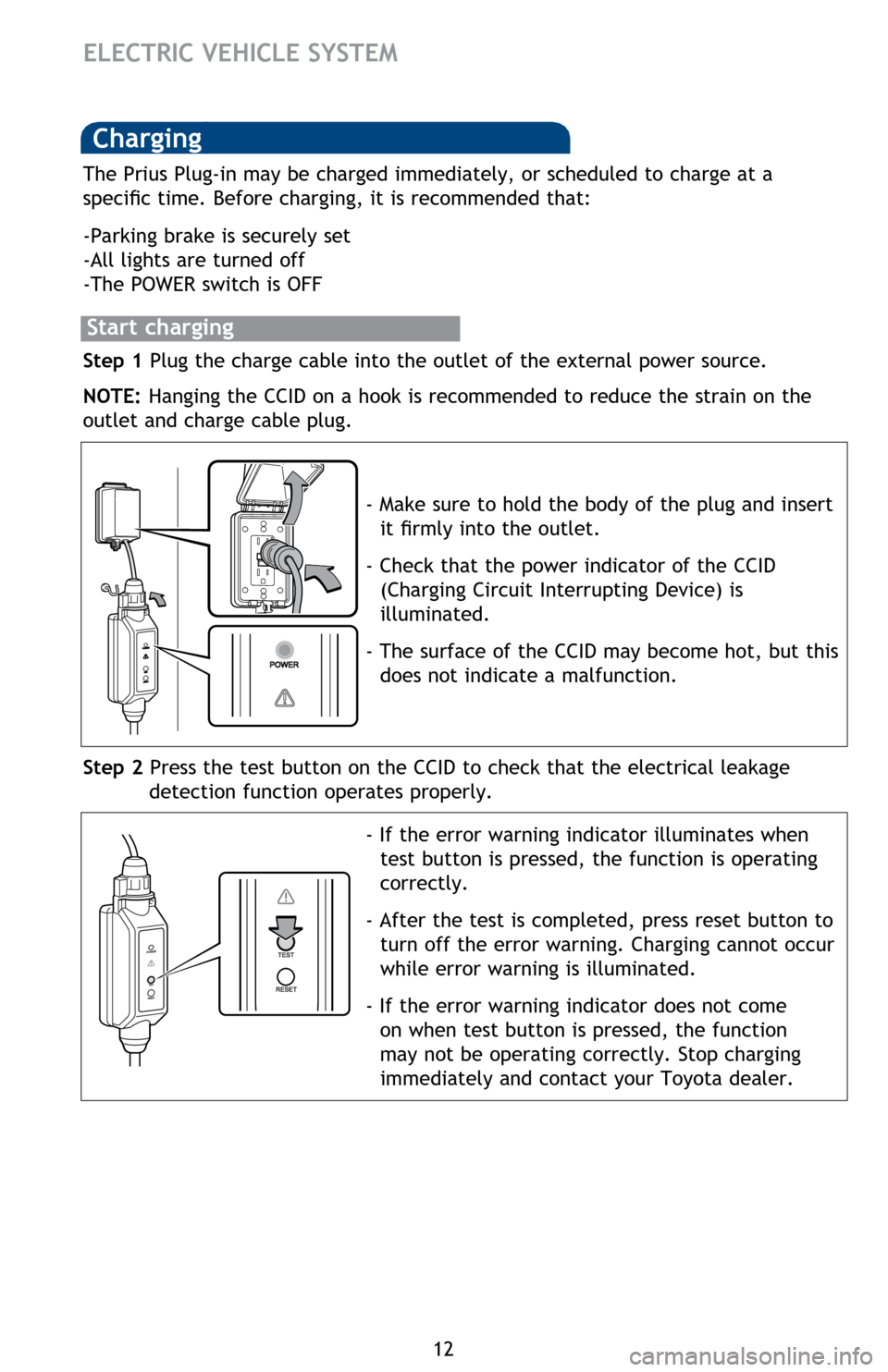
12
ELECTRIC VEHICLE SYSTEM
Charging
Step 1 Plug the charge cable into the outlet of the external power source.
NOTE: Hanging the CCID on a hook is recommended to reduce the strain on the
outlet and charge cable plug.
- Make sure to hold the body of the plug and insert it firmly into the outlet.
- Check that the power indicator of the CCID (Charging Circuit Interrupting Device) is
illuminated.
- The surface of the CCID may become hot, but this does not indicate a malfunction.
Step 2 Press the test button on the CCID to check that the electrical leakage detection function operates properly.
- If the error warning indicator illuminates when test button is pressed, the function is operating
correctly.
- After the test is completed, press reset button to turn off the error warning. Charging cannot occur
while error warning is illuminated.
- If the error warning indicator does not come on when test button is pressed, the function
may not be operating correctly. Stop charging
immediately and contact your Toyota dealer.
The Prius Plug-in may be charged immediately, or scheduled to charge at a
specific time. Before charging, it is recommended that:
-Parking brake is securely set
-All lights are turned off
-The POWER switch is OFF
Start charging
Page 16 of 40
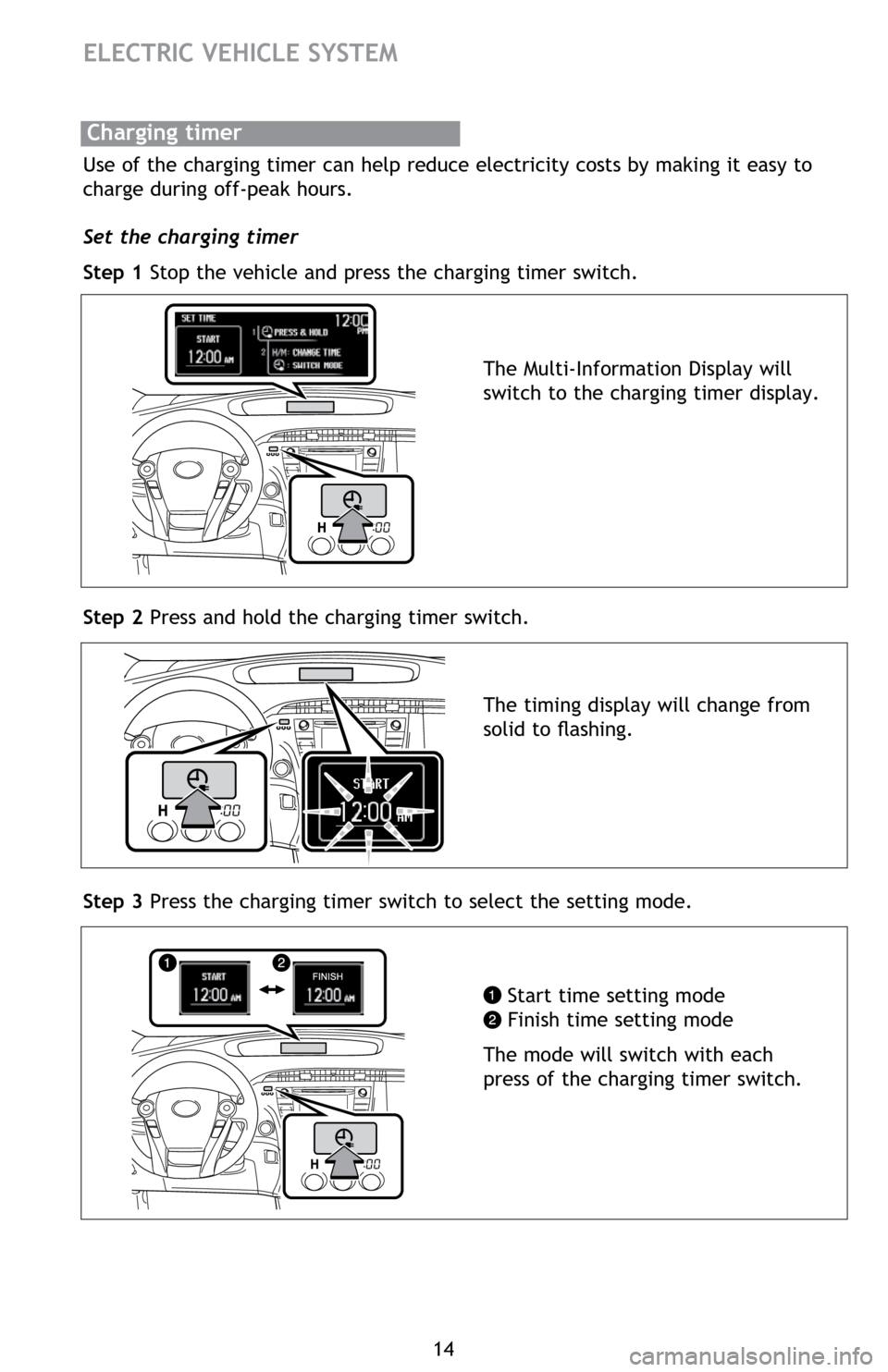
14
ELECTRIC VEHICLE SYSTEM
Use of the charging timer can help reduce electricity costs by making it easy to
charge during off-peak hours.
Set the charging timer
Step 1 Stop the vehicle and press the charging timer switch.
The timing display will change from
solid to flashing.
Charging timer
The Multi-Information Display will
switch to the charging timer display.
Step 2 Press and hold the charging timer switch.
Step 3 Press the charging timer switch to select the setting mode. Start time setting mode
Finish time setting mode
The mode will switch with each
press of the charging timer switch.
Page 21 of 40
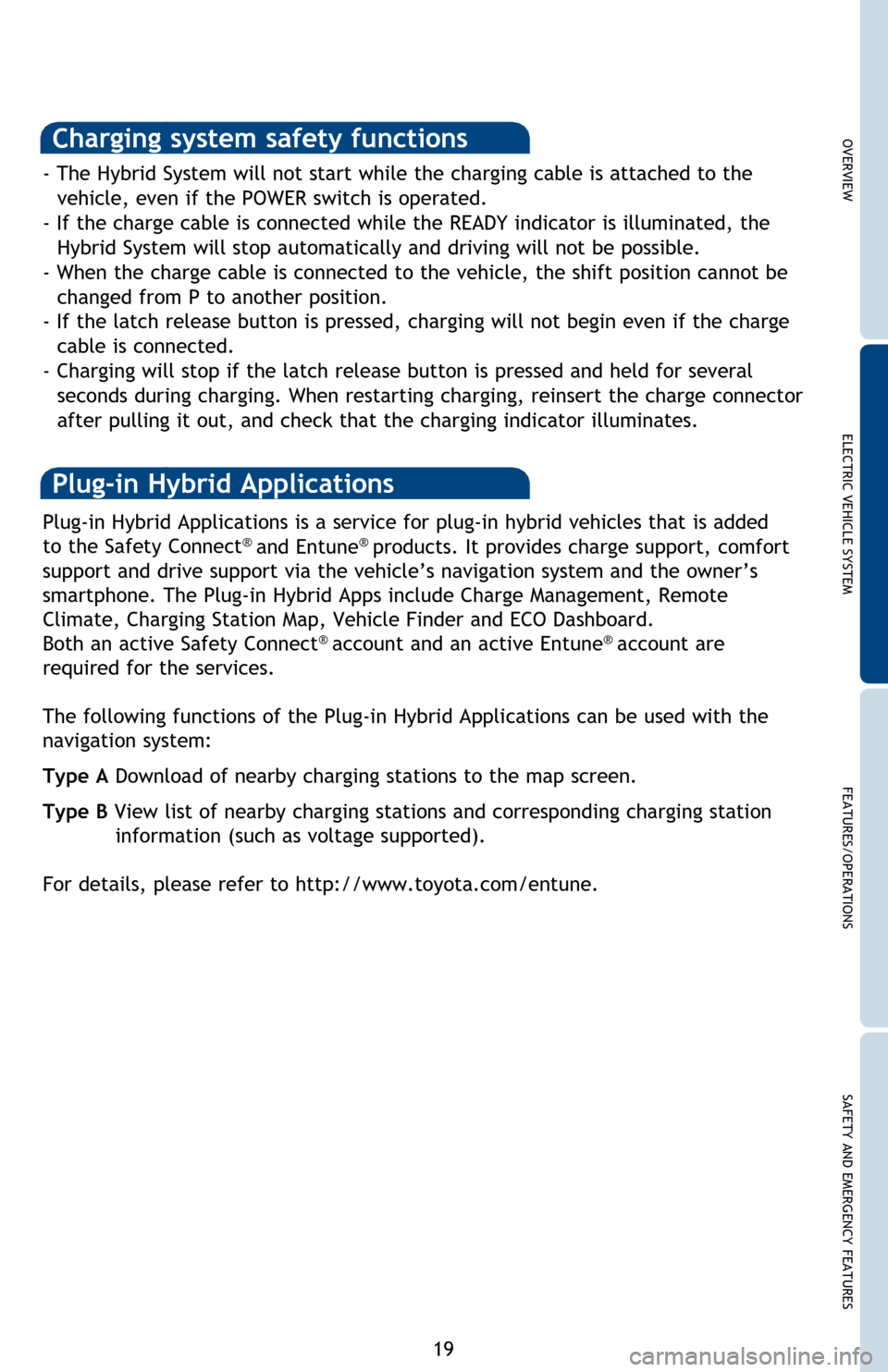
19
Charging system safety functions
- The Hybrid System will not start while the charging cable is attached to the vehicle, even if the POWER switch is operated.
- If the charge cable is connected while the READY indicator is illuminated, the Hybrid System will stop automatically and driving will not be possible.
- When the charge cable is connected to the vehicle, the shift position cannot be changed from P to another position.
- If the latch release button is pressed, charging will not begin even if the charge cable is connected.
- Charging will stop if the latch release button is pressed and held for several seconds during charging. When restarting charging, reinsert the charge connector
after pulling it out, and check that the charging indicator illuminates.
Plug-in Hybrid Applications is a service for plug-in hybrid vehicles that is added
to the Safety Connect® and Entune® products. It provides charge support, comfort
support and drive support via the vehicle’s navigation system and the owner’s
smartphone. The Plug-in Hybrid Apps include Charge Management, Remote
Climate, Charging Station Map, Vehicle Finder and ECO Dashboard.
Both an active Safety Connect
® account and an active Entune® account are
required for the services.
The following functions of the Plug-in Hybrid Applications can be used with the
navigation system:
Type A Download of nearby charging stations to the map screen.
Type B View list of nearby charging stations and corresponding charging station information (such as voltage supported).
For details, please refer to http://www.toyota.com/entune.
Plug-in Hybrid Applications
OVERVIEWELECTRIC VEHICLE SYSTEM FEATURES/OPERATIONS
SAFETY AND EMERGENCY FEATURES
Page 22 of 40
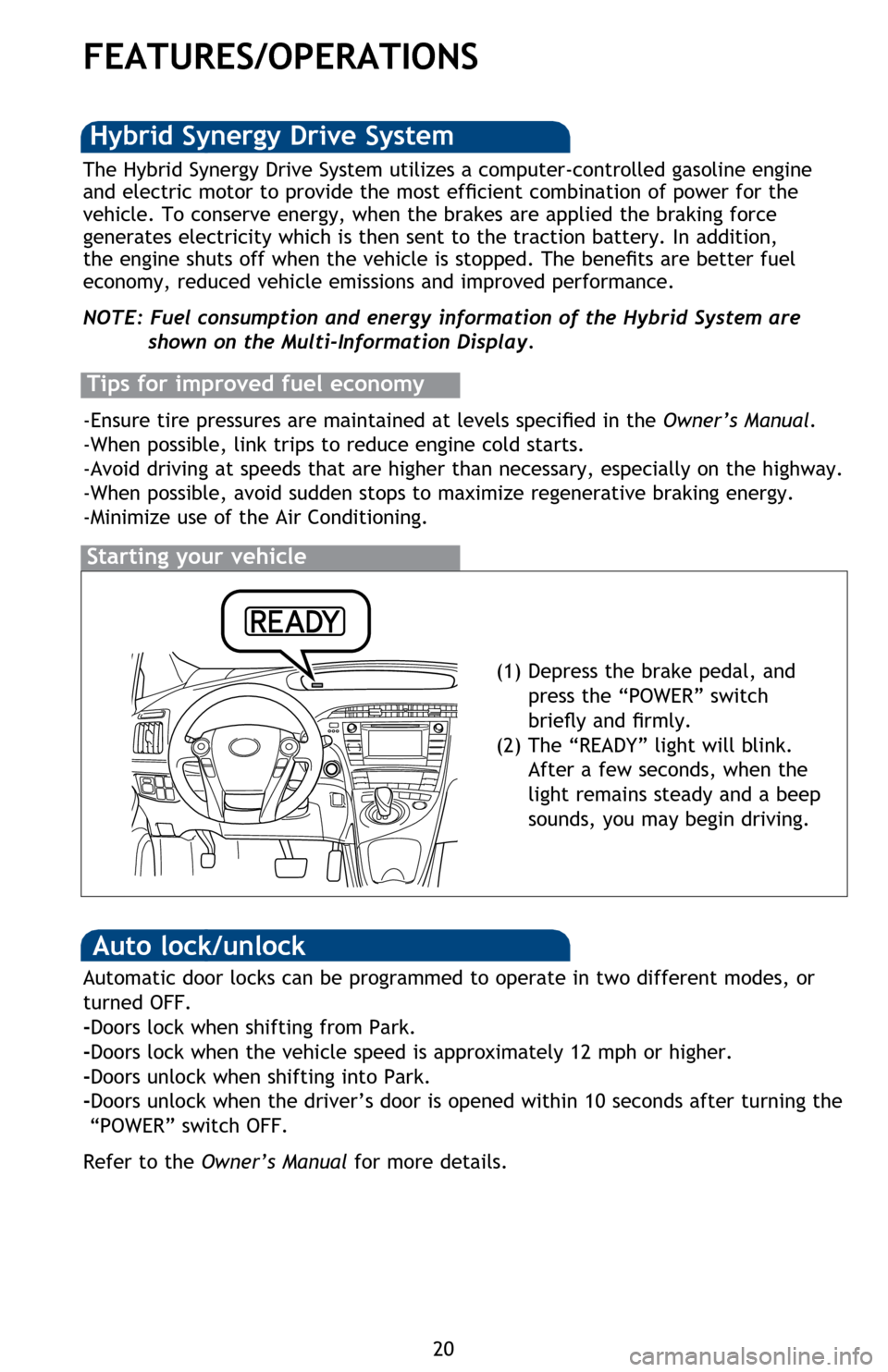
20
FEATURES/OPERATIONS
Starting your vehicle
The Hybrid Synergy Drive System utilizes a computer-controlled gasoline engine
and electric motor to provide the most efficient combination of power for the
vehicle. To conserve energy, when the brakes are applied the braking force
generates electricity which is then sent to the traction battery. In addition,
the engine shuts off when the vehicle is stopped. The benefits are better fuel
economy, reduced vehicle emissions and improved performance.
NOTE: Fuel consumption and energy information of the Hybrid System are shown on the Multi-Information Display.
Tips for improved fuel economy
-Ensure tire pressures are maintained at levels specified in the Owner’s Manual.
-When possible, link trips to reduce engine cold starts.
-Avoid driving at speeds that are higher than necessary, especially on the highway.
-When possible, avoid sudden stops to maximize regenerative braking energy.
-Minimize use of the Air Conditioning.
Hybrid Synergy Drive System
Auto lock/unlock
Automatic door locks can be programmed to operate in two different modes, or
turned OFF.
-Doors lock when shifting from Park.
-Doors lock when the vehicle speed is approximately 12 mph or higher.
-Doors unlock when shifting into Park.
-Doors unlock when the driver’s door is opened within 10 seconds after turning the
“POWER” switch OFF.
Refer to the Owner’s Manual for more details. (1) Depress the brake pedal, and
press the “POWER” switch
briefly and firmly.
(2) The “READY” light will blink. After a few seconds, when the
light remains steady and a beep
sounds, you may begin driving.
Page 33 of 40
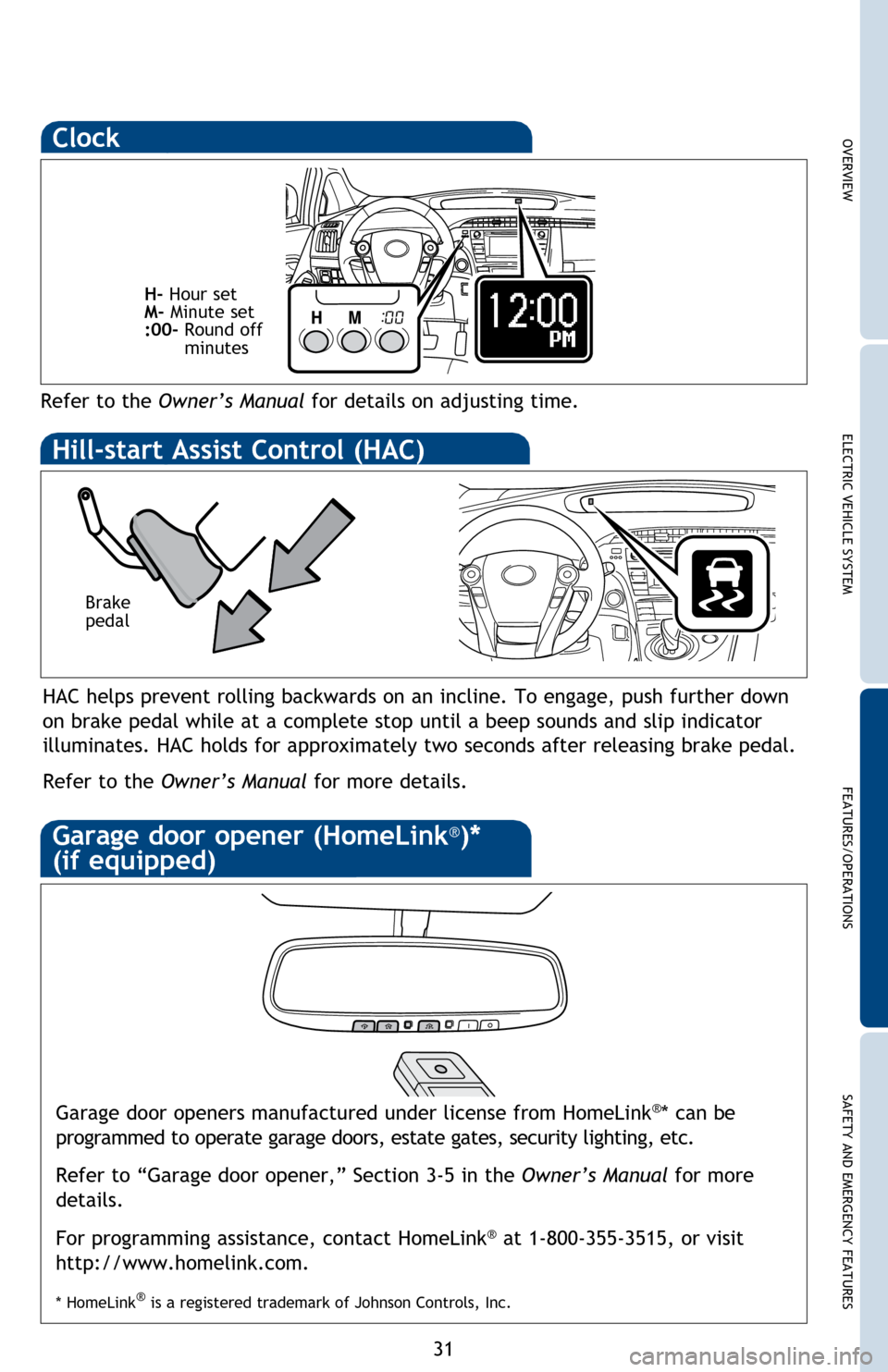
31
Clock
Refer to the Owner’s Manual for details on adjusting time.
H- Hour set
M- Minute set
:00- Round off
minutes
HAC helps prevent rolling backwards on an incline. To engage, push further down
on brake pedal while at a complete stop until a beep sounds and slip indicator
illuminates. HAC holds for approximately two seconds after releasing brake pedal.
Refer to the Owner’s Manual for more details.
Brake
pedal
Hill-start Assist Control (HAC)
Garage door openers manufactured under license from HomeLink®* can be
programmed to operate garage doors, estate gates, security lighting, etc\
.
Refer to “Garage door opener,” Section 3-5 in the Owner’s Manual for more
details.
For programming assistance, contact HomeLink
® at 1-800-355-3515, or visit
http://www.homelink.com.
* HomeLink® is a registered trademark of Johnson Controls, Inc.
Garage door opener (HomeLink®)*
(if equipped)
OVERVIEWELECTRIC VEHICLE SYSTEM FEATURES/OPERATIONS
SAFETY AND EMERGENCY FEATURES
Page 36 of 40
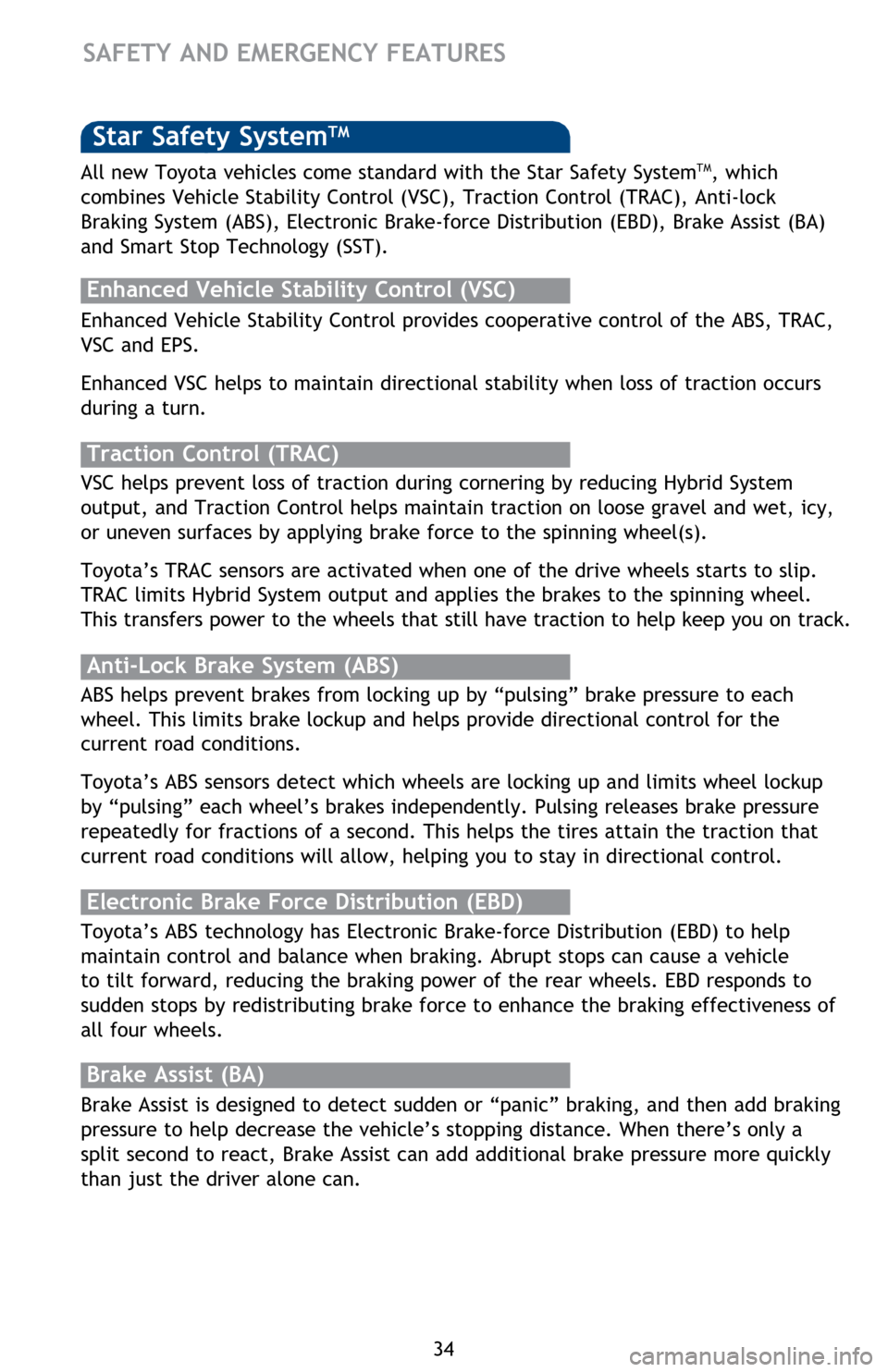
34
Star Safety SystemTM
Enhanced Vehicle Stability Control provides cooperative control of the ABS, TRAC,
VSC and EPS.
Enhanced VSC helps to maintain directional stability when loss of traction occurs
during a turn.
Enhanced Vehicle Stability Control (VSC)
Anti-Lock Brake System (ABS)
ABS helps prevent brakes from locking up by “pulsing” brake pressure to each
wheel. This limits brake lockup and helps provide directional control for the
current road conditions.
Toyota’s ABS sensors detect which wheels are locking up and limits wheel lockup
by “pulsing” each wheel’s brakes independently. Pulsing releases brake pressure
repeatedly for fractions of a second. This helps the tires attain the traction that
current road conditions will allow, helping you to stay in directional control.
Brake Assist (BA)
Brake Assist is designed to detect sudden or “panic” braking, and then add braking
pressure to help decrease the vehicle’s stopping distance. When there’s only a
split second to react, Brake Assist can add additional brake pressure more quickly
than just the driver alone can. VSC helps prevent loss of traction during cornering by reducing Hybrid System
output, and Traction Control helps maintain traction on loose gravel and wet, icy,
or uneven surfaces by applying brake force to the spinning wheel(s).
Toyota’s TRAC sensors are activated when one of the drive wheels starts to slip.
TRAC limits Hybrid System output and applies the brakes to the spinning wheel.
This transfers power to the wheels that still have traction to help keep\
you on track.
Traction Control (TRAC)
Electronic Brake Force Distribution (EBD)
Toyota’s ABS technology has Electronic Brake-force Distribution (EBD) to help
maintain control and balance when braking. Abrupt stops can cause a vehicle
to tilt forward, reducing the braking power of the rear wheels. EBD responds to
sudden stops by redistributing brake force to enhance the braking effectiveness of
all four wheels.
SAFETY AND EMERGENCY FEATURES
All new Toyota vehicles come standard with the Star Safety SystemTM, which
combines Vehicle Stability Control (VSC), Traction Control (TRAC), Anti-lock
Braking System (ABS), Electronic Brake-force Distribution (EBD), Brake Assist (BA)
and Smart Stop Technology (SST).